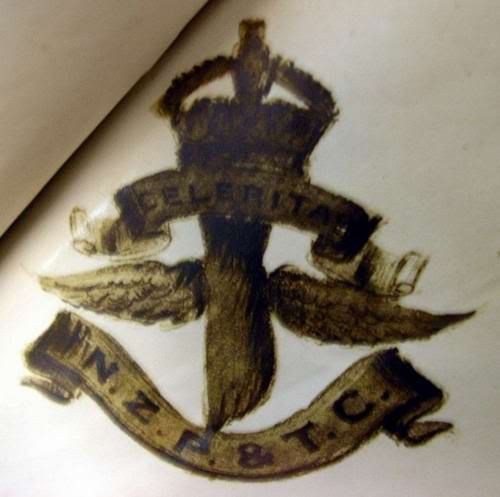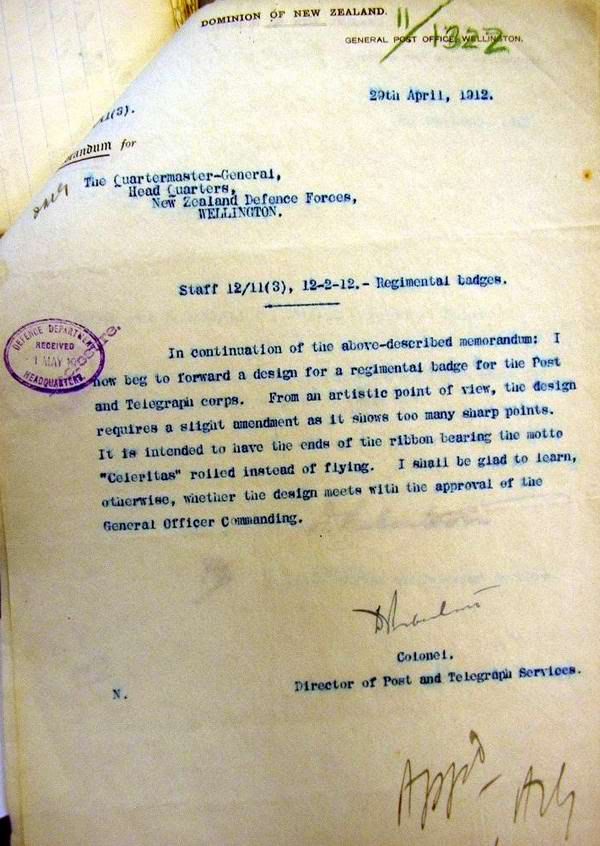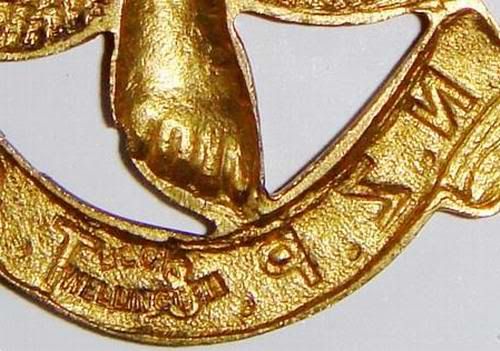Quote:
Originally Posted by Quicksilver

Brent,
I concur with your comments re the Specialists and am impressed with your knoweldge of the MG Specialists. Attached is a pix of a bronze collar. I have seen the cap as well. As they are regimental signallers and so many varieties, gold, bronze etc I gave up trying to get more varieties, and I suspect people may have been bronzing the brass ones. As regards the NZPT buttons in silver. Yes, I have seen them and may have one. Not sure if I still have it. A number of people told me that they were not military and I must admit I have no reason to believe that they are. However, perhaps some one has a dress reg to prove it. The silvered NZP&TC silver collar I have is rather interesting in that it has had a brooch fitting applied. The lugs have been cut off and it shows bronze where it is cut which indicates it was silvered before becoming a brooch.
Quicksilver
|
Hi Cliff,
My grandfather served with the 27th MG Battalion in WW2 so the NZMGC is high on my interest list.
Unfortunately I am certainly no expert when it come to NZ Signals badges, and as yet, I have not read your book “Swift and Sure: A History of the Royal New Zealand Corps of Signals and Army Signalling in New Zealand.”
So your joining the discussion is rather timely as I have more questions than answers, and your input/corrections and answers would be much appreciated. Most of my questions pertain to the origins of the 1912 – 1921 NZ Signal Corps badge, but seen as we have started with the NZP&TC badge, we can do it next up.
In regards to the silver NZP&TC buttons, they are common, and I too believe they are civilian not military.
The Silver NZP&TC cap badges are not that common, I can only speculate that they were either done for one specific occasion or most likely IMO it is a simple conversion into a patriotic badge.
As for your silvered collar NZP&T badge with brooch fitting, I would think that it was worn and then silvered to convert it to a patriotic badge.
Unfortunately the NZ Dress Regs are only good for shoulder titles and totally useless when it comes to Corps and Regimental badges, as apart from their being approved by the GCO and registered with the Quartermaster Generals office, cap and collar badges were entirely up to the Corps or Regiments to supply.
The good thing is that I do have quite a lot of information on Wellington Volunteer and Territorial Regiments from which the nucleus of the NZP&TC was formed from.
The Post and Telegraph Corps in a bit of a round about way can be traced back to the ‘Wellington Post and Telegraph Rifle Volunteers’ who were formed on the 8th June 1898. (Gazetted June 1898, with acceptance date 21st May 1898).
The Wellington Post and Telegraph Rifles were formed as a ‘rifle company’ with Mr. William Russell Morris was elected Captain. Their official designation was “E” Company, 1st Battalion Wellington Rifle Volunteers.
In early October 1905, the Post and Telegraph Rifles received authority to increase their establishment by two officers and thirty-four men to form a signalling section.
In early January 1911, A memorandum was issued from headquarters to officers commanding districts stating that the “cycle and signalling companies at each of the four centres will form the nuclei of the infantry brigade signal companies; the signal companies for the mounted brigades are to be formed at suitable centres in each district.”
When General Alexander Godley redesignated the Territorial Regiments on the 17th March 1911, the order of precedence was not given according to seniority, instead it was simply based on the order in which they were redesignated.
At this stage the Wellington Post and Telegraph Rifle Volunteers were reformed as “E” Company, 5th Regiment (Wellington Rifles).
In May 1911, “E” Company, 5th Regiment (Wellington Rifles) was reformed into an infantry brigade signal corps, to be known as the Wellington Infantry Brigade Signal Corps.
On the 7th October 1911, the formation of the NZ Post and Telegraph Corps was authorised as part of the Public Service Corps. —
The main reason for the formation of the NZP&T corps was to establish and keep open lines of communication, and the training of the men was carried out with that objective kept always in view. The nucleus for the formation was initially drawn from the Wellington Infantry Brigade Signal Corps
David Robertson (Secretary to the Post and Telegraph Department) was appointed as Director of Post and Telegraph Services, with the rank of Colonel.
Lieutenant Colonel William Russell Morris (Assistant Secretary to the Post and Telegraph Department) who was instrumental in forming the Wellington Post and Telegraph Rifles in 1898, and held the command of that company for ten years, was appointed as Staff-Officer to Director of post and Telegraph Services, with the rank of Lieutenant-Colonel.
Lieutenant Colonel Morris was probably the most instrumental in the organisation of the Post and Telegraph Corps. On the 1st January 1913, when Mr. Robertson was appointed to the position of Public Service Commissioner, Colonel Morris replaced him as Director of Post and Telegraph Services, a position that he held until June 1920.
(Lieutenant Colonel D. Miller who was the first commanding officer of the Civil Service Rifles became Colonel Morris's chief assistant.)
The following is the original sketch presented to the Quartermaster Generals office on application as a regimental badge. Given its similarities to a sketch of the original Maori Battalion badge, I would suspect the Defence Department draughtsman did the sketches.
The badges Latin motto “Celeritas” translates as Swiftly, swiftness or “speed.”
The winged foot of ‘Mercury the messenger of the gods’ alludes to the message service performed by the unit.

The following is the original submission for the approval for the badge.

The following is the original submission by Colonel Robertson requesting permission from the GOC, which is notarised as approved at the bottom.

J. R. Gaunt was the official badge supplier to the New Zealand Government and as such was the first to produce the NZP&TC cap and collar badges. When the NZ Government dropped Gaunt as a supplier around April 1917, it would be likely the NZP&TC would have followed suit.
It is mere speculation on my part, but I suspect Wellington badge maker William Bock made the New Zealand NZP&TC badge dies and produced the second run of badges. The Bock NZP&TC badge dies would have been stored with the defence department and issued to badge suppliers when more badges were required.
(A comparison of badges needed to test this theory)

As for the NZP&TC shoulder titles, these unfortunately were not authorised by the time the 1912 NZ Dress Regulations were printed. I can however pin point that they were authorised in September 1912 or at the very beginning of October 1912. (Manufactured by Gaunt up until April 1917)
On the 1st July 1913 the NZ Post and Telegraph Corps were placed under the NZ Engineers.
By the outbreak of WW1, the Post and Telegraph Corps organisation had been completed.
The NZP&T corps was divided into two battalions, one in the North Island and one in the South Island, and comprised of a total of thirteen companies.
Lieutenant-Colonel G. B. Harton was in command of the North Island Battalion and Captain A. M. Rattray acted as O.C. of the South Island Battalion. Prior to the war there was around 980 men enrolled.
(In addition there were four companies of Senior Cadets, with strength of around 600 that was under the NZP&TC)
My questions are. —
Why was the NZP&TC badge adopted by the NZ Signal Corps in 1921????
Were the NZP&TC the first to use ‘Mercury the messenger of the gods’ as a unit insignia or was it the British or USA?????